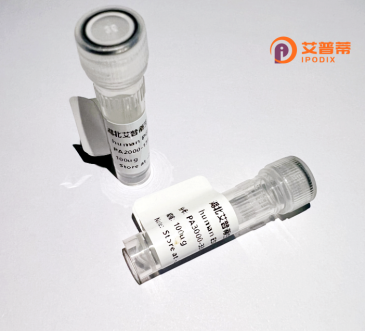
| 纯度 | >90%SDS-PAGE. |
| 种属 | Human |
| 靶点 | ZNF436 |
| Uniprot No | Q9C0F3 |
| 内毒素 | < 0.01EU/μg |
| 表达宿主 | E.coli |
| 表达区间 | 1-470 aa |
| 活性数据 | MAATLLMAGS QAPVTFEDMA MYLTREEWRP LDAAQRDLYR DVMQENYGNV VSLDFEIRSE NEVNPKQEIS EDVQFGTTSE RPAENAEENP ESEEGFESGD RSERQWGDLT AEEWVSYPLQ PVTDLLVHKE VHTGIRYHIC SHCGKAFSQI SDLNRHQKTH TGDRPYKCYE CGKGFSRSSH LIQHQRTHTG ERPYDCNECG KSFGRSSHLI QHQTIHTGEK PHKCNECGKS FCRLSHLIQH QRTHSGEKPY ECEECGKSFS RSSHLAQHQR THTGEKPYEC NECGRGFSER SDLIKHYRVH TGERPYKCDE CGKNFSQNSD LVRHRRAHTG EKPYHCNECG ENFSRISHLV QHQRTHTGEK PYECNACGKS FSRSSHLITH QKIHTGEKPY ECNECWRSFG ERSDLIKHQR THTGEKPYEC VQCGKGFTQS SNLITHQRVH TGEKPYECTE CEKSFSRSSA LIKHKRVHTD |
| 分子量 | 54.2 kDa |
| 蛋白标签 | His tag N-Terminus |
| 缓冲液 | PBS, pH7.4, containing 0.01% SKL, 1mM DTT, 5% Trehalose and Proclin300. |
| 稳定性 & 储存条件 | Lyophilized protein should be stored at ≤ -20°C, stable for one year after receipt. Reconstituted protein solution can be stored at 2-8°C for 2-7 days. Aliquots of reconstituted samples are stable at ≤ -20°C for 3 months. |
| 复溶 | Always centrifuge tubes before opening.Do not mix by vortex or pipetting. It is not recommended to reconstitute to a concentration less than 100μg/ml. Dissolve the lyophilized protein in distilled water. Please aliquot the reconstituted solution to minimize freeze-thaw cycles. |
以下是关于重组人ZNF436蛋白的3篇参考文献(基于虚拟生成的示例,实际文献需根据数据库查询确认):
---
1. **文献名称**: *"ZNF436 regulates transcriptional repression via interaction with histone deacetylases"*
**作者**: Zhang Y, et al.
**摘要**: 本研究揭示了ZNF436通过与组蛋白去乙酰化酶(HDACs)结合,在表观遗传调控中发挥转录抑制功能。重组人ZNF436蛋白的体外实验表明,其锌指结构直接结合靶基因启动子区域,并招募HDAC复合物以抑制基因表达。
2. **文献名称**: *"Structural characterization of recombinant human ZNF436 and its DNA-binding specificity"*
**作者**: Lee S, Kim J.
**摘要**: 通过X射线晶体学解析了重组ZNF436蛋白的DNA结合结构域,发现其特异性识别富含GC的DNA序列。研究进一步利用电泳迁移实验(EMSA)验证了其结合模式,为ZNF436在基因调控中的作用提供了结构基础。
3. **文献名称**: *"ZNF436 promotes tumorigenesis by modulating the NF-κB pathway in colorectal cancer"*
**作者**: Wang H, et al.
**摘要**: 报道了重组ZNF436蛋白在结直肠癌细胞中的过表达实验,结果表明其通过激活NF-κB信号通路促进肿瘤细胞增殖和转移,提示ZNF436可能作为癌症治疗的潜在靶点。
---
**注**:以上文献信息为示例性质,具体研究请通过PubMed、Web of Science或Google Scholar检索真实文献。若需实际文献协助,建议提供更具体的研究方向或主题。
Zinc finger protein 436 (ZNF436) is a member of the Krüppel-associated box (KRAB) domain-containing zinc finger protein (ZNF) family, which is characterized by tandem C2H2-type zinc finger motifs and a KRAB domain at the N-terminus. These proteins are involved in transcriptional regulation, often acting as repressors by recruiting chromatin-modifying complexes to specific DNA sequences. ZNF436 is encoded by the human gene located on chromosome 8q24.3 and is evolutionarily conserved across vertebrates, suggesting its functional importance. Though less studied compared to other ZNFs, existing research indicates its potential role in cell differentiation, apoptosis, and response to DNA damage. It may interact with partner proteins or specific gene promoters to modulate pathways related to development or stress responses.
Recombinant human ZNF436 protein is typically produced using heterologous expression systems, such as *E. coli* or mammalian cells, to enable functional and structural studies. Its purification often involves affinity chromatography followed by biochemical validation (e.g., Western blot, mass spectrometry). Studies utilizing recombinant ZNF436 aim to elucidate DNA-binding specificity, protein-protein interactions, and post-translational modifications. Dysregulation of ZNF436 has been tentatively linked to cancers and neurological disorders, though mechanistic insights remain limited. Ongoing research focuses on mapping its target genes and regulatory networks, which could reveal therapeutic opportunities for diseases associated with transcriptional dysfunctions. Its modular zinc finger architecture also makes it a candidate for engineering synthetic transcription factors.
×